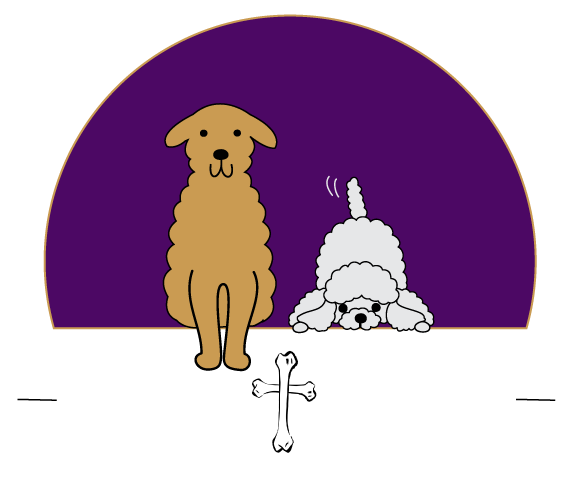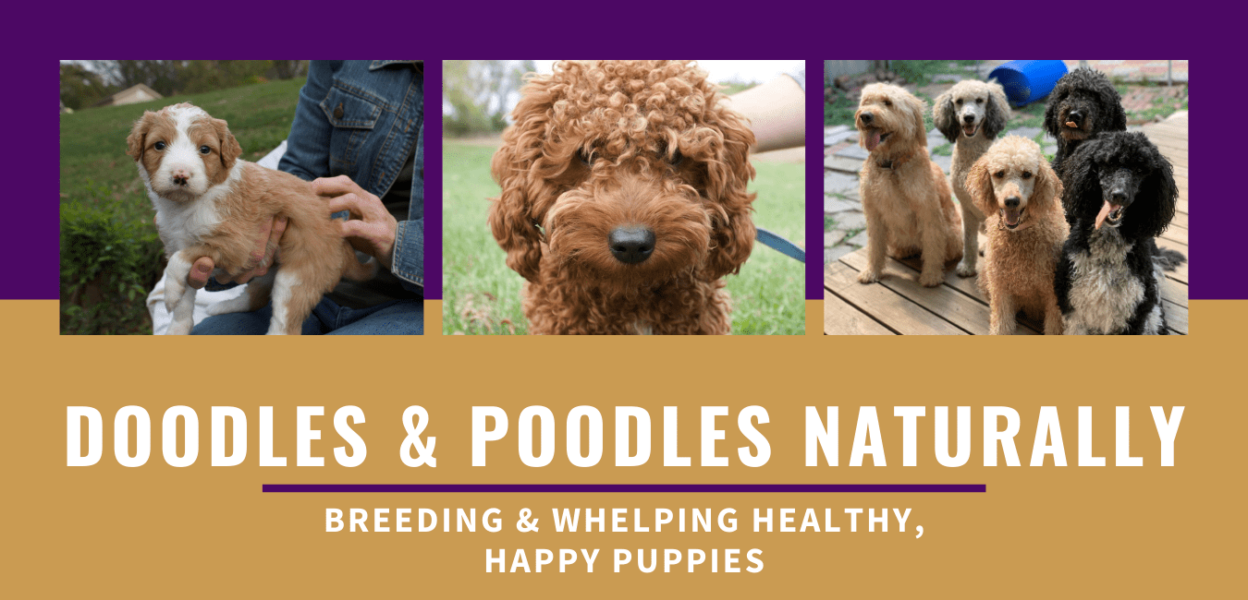Some Helpful Tips to Make a Smooth(er) Transition
All Things Feeding & Chewing
Food: At Doodles and Poodles Naturally, we continuously research the best, most ethical dog food formulas available, and we also provide our dogs and puppies (when they are old enough) with raw food days. Ask us about the specifics of what your puppy has been eating and we will be glad to tell you all about it. If you decide to change foods at any time, it’s important to make this transition gradually, especially for a puppy, adding a little bit of new food to their older food each day until you’ve made a complete switch. Your puppy has been enjoying their meals along with their siblings, so it is very hard to be sure of exactly how much they eat until they are on their own. Fortunately, you can consult your dog food label for suggested amounts by age and weight. You can also notice whether your puppy leaves some food in the bowl after meals. If so, you can cut the feeding amount back a tiny bit, but be sure to increase it gradually as your puppy grows. They will have a lot of growth spurts during their first year, and they can even have growth spurts for up to two years of age.
Treats: Treats are loads of fun, but should not be loads of food. Try and keep treating to a minimum in your puppy’s diet. Consult labels for store bought treats for suggested amounts by age and weight. For things like table scraps, consider whether the puppy would be eating anything like this as a canine in the wild, and limit accordingly. The more natural and meaty the treat the better. Some doggies enjoy fresh fruit and vegetables. (NO GRAPES! Sprays used on grapes, even some “organic grapes” can be very toxic for dogs.) Always notice what happens to your puppy’s stools and energy when they try a new treat. How does it sit with their digestive tract? Not so good? They might need to take in less of it at a time, wait until they’re older to enjoy that treat, or skip that one entirely.
Label Check: Check labels and don’t be misled by deceptive advertising. There are unfortunately a number of junk food treats and kibbles made for puppies and dogs. You will learn by reading labels, trial and error, and perhaps doing a bit of reading and sleuthing, what treats and food your puppy really loves and does well with. Notice how their coat, energy, teeth and stools are all reacting to their diet. They should have lots of energy, regular stools, shiny coats, and white teeth. We strongly suggest feeding treats and food that are grain-free and also very low in starch.
How Often to Feed: Your puppy eats 3 times a day. Currently, your puppy eats breakfast early in the morning (about 6 or 7am), lunch at about 11am, and their last meal is at 4pm. To avoid accidents, we suggest not feeding them after 4pm and no water after 6pm. Water should be available pretty much all day until you remove it, usually about 2 hours before bedtime. This will help prevent a lot of wake-ups at night to pee and poo.
Chew Bones & Toys: Natural, safe chew bones are great for helping puppies teethe, providing entertainment for kennel time with you nearby, and cutting teeth without chewing on hands and non-dog-toys. We like the Castor & Pollux brand, Good Buddy natural rawhides. Don’t overdo these rawhides or chew bones. Check the packaging for suggested amounts, provide plenty of water with them, and take a break from them for a couple of days if stools seem loose. Don’t resume until stools completely normalize. You can also supply non-toxic chew toys that are not consumed. It’s important to watch your puppy when they have a rawhide or other chew bone, as they could choke if they bite off too much at once.
Keep your eye on your puppy if they have a stuffed toy or any new toy to assure that they are not actually eating it. Toy and bed stuffing and other toy pieces do often pass through a dog’s stools, but they can create a blockage, and it’s not really food, so it’s best not to be eaten.
Crate & House Training
Crate Training: If you choose to crate train, and we suggest you do to avoid accidents or chewed up toys that aren’t for the puppy, as well as to support general sanity for all of your household, it’s important to make the crate a safe, positive space, and not a space where your puppy feels like they are being punished or bored to death. The crate should be just big enough for them to stand up, turn around, and lay down. Any bigger than this and puppies tend to find a “corner” they can go eliminate in. They have an instinct to avoid eliminating in their own bed space. If you want to get a bigger crate to start with so that your puppy can grow into it, many crates have dividers you can use to adjust as your puppy grows.
Here is a link to watch a little video that talks about controlling your environment when you bring a puppy into the home, and specifically about crate training.
House Training: House training is easier than you think – especially if you incorporate crate training at the same time. Celebrate progress and remember that your puppy may not do perfectly at first, but with your consistency and positive reinforcement, they’ll become accident-free. Here is a link to a helpful video on potty training your puppy during the day.
Getting Through the Night
Maybe we should have started here. Don’t worry, nights of interrupted sleep won’t last forever! Your puppy is growing fast, but they are still a baby and they will need to go to the bathroom at night, but this will not last very long, FAR less than for human babies.
What to Expect for Sleeping: The length of time between waking up to go to the bathroom continues to lengthen as your puppy ages and eventually it becomes a thing of the past. You’ll need to know what to expect to avoid accidents or causing your puppy to “hold it” for too long.
Here is some extra info to help you plan for getting through the night with your puppy, including what is normal regarding your expectations for how long they can hold their bladder, poo, etc. as they develop.
Evening Potty Time: In the evenings, it’s a good idea to let your puppy out as late as you can within your sleep schedule. You might have to carry them outside and wait for them to pee and maybe poo, you may even have to wake them a little to get them going. After they go, or it becomes apparent that they are not going to wake up to go, carry them back inside and gently place them directly into their crate for bedtime. Avoiding Crazy Early Mornings: When your puppy wakes up in the morning earlier than you want them to, pick them up and carry them outside to do their potty and poo business, then carry them back inside and put them in their crate or other controlled space. Don’t talk to your puppy or play with them at this time. That will let them know that this is not playtime yet, and it will help you to set up good habits for the future when they do sleep through the night. They’ll quickly learn to get up for the day on your daily schedule.




